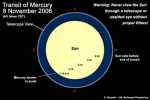Opinion
Mercury crossing the face of the sun
Monday, October 30, 2006

A relatively rare astronomical event will occur next Wednesday, Nov. 8. The planet Mercury will transit, or cross, the face of the Sun. Most of that transit will be visible here in Southwest Nebraska, although the Sun sets before the transit is over.
Transits are only possible when the orbital plain of the two innermost planets, Mercury or Venus, cross the plane of Earth's orbit. In other words, the Sun, Mercury or Venus, and the Earth must form a nearly perfect line for a transit to occur.
A transit of Mercury can only occur in early May or mid-November. The November transits recur at intervals of 7, 13, or 33 years while the May transits recur at intervals of 13 or 33 years.
The last transit of Mercury visible in North America was in May of 2003. For Mercury, after the 2006 transit, the next crossings will be May 9, 2016, Nov. 11, 2019, Nov. 13, 2032 and Nov. 7, 2039. Mercury will transit 13 times each century.
For Venus the transit intervals are much rarer. They can only occur in early December and early June. Its recurrence pattern is in intervals of 8, 121.5, 8 and 105.5 years. Venus will cross the face of the Sun in pairs eight years apart with more than a century between each pair. The last pair of transits for Venus was in 1874 and 1882.
The next transit for Venus will be on June 6, 2012 (the most recent transit in the currant pair was in 2004), and is better timed for viewers in North America. The next pair of transits for Venus will be in 2117 and 2125.
If you would like to view the transit, Jim Garretson at McCook Community College will have a telescope set up outside Barnett Hall starting at 1:30 pm CST.
If the sky is clear, it will be a good opportunity to view with your own eyes one of these rare celestial happenings.
WARNING: Proper eye protection is a MUST when viewing the Sun, otherwise permanent eye damage can result!
My telescope will be equipped with a solar filter, allowing for safe views. Because Mercury is so small, a filtered telescope will probably be necessary to view the transit.
SKY WATCH: If we had a longer period of dark, we could watch the Moon occult the Pleiades star cluster, again, on Sunday, Nov. 5.
The full Moon will be very near the cluster starting just after it rises in the early evening and will be getting closer all night.
The occultation will happen after sunrise on Monday the 6th after both the Pleiades and the Moon have set in the west. We missed the last occultation in October due to clouds and rain.
That's OK; we will see another one on Dec., 3, if we don't have clouds that is. Full Moon on Sunday, Nov. 5.
Next time, Cassiopeia and Cepheus.

